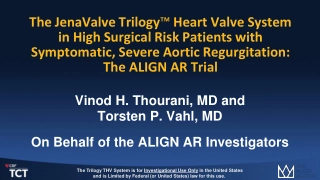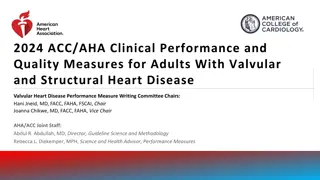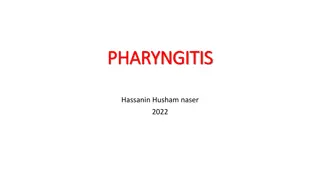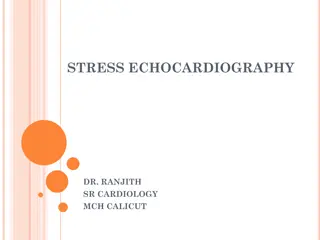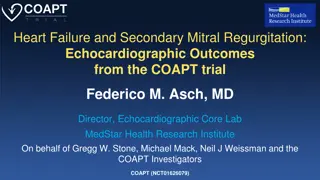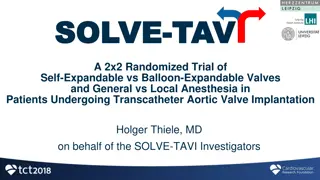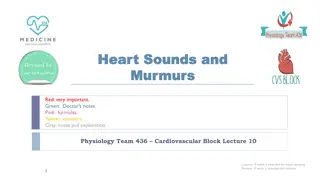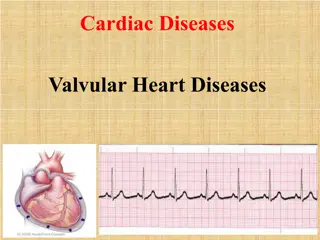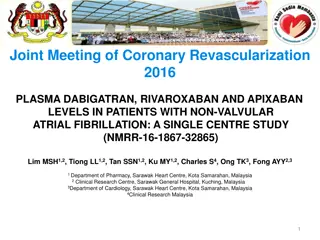ALIGN.AR Trial: JenaValve Trilogy for Aortic Regurgitation
The ALIGN.AR trial evaluates Trilogy THV system in high-risk patients with severe aortic regurgitation. Untreated AR is linked to high mortality, emphasizing the need for safe alternative interventions like TAVR devices. The study aims to demonstrate safety and effectiveness of the Trilogy valve in
0 views • 37 slides
Infectious Endocarditis
A 22-year-old female patient with a history of infected endocarditis and recent dental procedure presents with high-grade fever, chills, shortness of breath, and arthralgia. Examination reveals a pan systolic murmur and tachycardia. Echocardiography shows mitral regurgitation with vegetation on the
1 views • 32 slides
Understanding Acute Rheumatic Fever: Causes, Symptoms, and Impact
Acute Rheumatic Fever (ARF) is a multisystem disease resulting from an autoimmune response to a sore throat caused by Group A beta-hemolytic Streptococci. It primarily affects children aged 5-14 years and can lead to rheumatic heart disease (RHD), which is the most common cause of heart disease in c
2 views • 48 slides
ACC/AHA Clinical Performance Measures for Valvular Heart Disease
This document highlights the development of performance measures for adults with valvular heart disease by a writing committee, providing 11 measures for clinical use. The measures are divided into performance and quality categories, with emphasis on applicability, areas of improvement, and potentia
0 views • 13 slides
Understanding Pharyngitis: Causes, Symptoms, and Management
Pharyngitis is an inflammation of the pharynx characterized by coughing, painful swallowing, and appetite changes. It can be caused by physical or infectious factors, leading to symptoms such as virtual obstruction, regurgitation, and drooling. Understanding the etiology and pathogenesis is crucial
1 views • 32 slides
Comprehensive Guide to Stress Echocardiography in Cardiology Practice
Stress echocardiography is a valuable tool in diagnosing and managing coronary artery disease, valvular heart disease, and assessing heart function. This imaging technique helps in detecting flow-limiting stenosis, understanding the ischemic cascade, and evaluating cardiac function during stress. Va
0 views • 49 slides
Understanding Achalasia: Therapeutic Approaches, Pathophysiology, and Clinical Manifestations
Achalasia is characterized by a failure of the lower esophageal sphincter to relax, leading to difficulty in swallowing and regurgitation. The exact cause is unknown, but autoimmune factors and chronic infections may play a role. Symptoms include dysphagia, chest pain, regurgitation, and weight loss
0 views • 59 slides
Chronic Primary Mitral Regurgitation: Evaluation and Management Considerations
Chronic primary mitral regurgitation (MR) presents various considerations in evaluating severity, symptoms, left ventricular function, and candidacy for mitral valve repair. The management decision involves assessing imaging findings, LV function, and the impact on mortality and quality of life. Sur
0 views • 9 slides
Echocardiographic Outcomes in Heart Failure Patients with Secondary Mitral Regurgitation: COAPT Trial
This study presents the echocardiographic outcomes from the COAPT trial focusing on heart failure patients with secondary mitral regurgitation. The trial evaluated the impact of MitraClip therapy in conjunction with guideline-directed medical therapy compared to medical therapy alone. Results showed
0 views • 27 slides
Comparison of Valve Types and Anesthesia Strategies in Transcatheter Aortic Valve Implantation
In the SOLVE-TAVI trial, patients undergoing transcatheter aortic valve implantation were randomized to receive either self-expandable or balloon-expandable valves under general or local anesthesia. The study aims to compare the effectiveness and safety of different valve types and anesthesia approa
0 views • 27 slides
Understanding Heart Sounds and Murmurs in Cardiovascular Physiology
This detailed lecture covers the basics of normal and abnormal heart sounds, stethoscope placement, cardiac auscultation, and the physiological significance of heart murmurs. It explains the causes, descriptions, and grading of abnormal heart sounds, along with specific conditions like aortic stenos
0 views • 26 slides
Understanding Mitral Stenosis: Causes, Symptoms, and Pathophysiology
Mitral stenosis is a valvular heart disease characterized by narrowing of the mitral valve orifice, leading to decreased blood flow and various complications. Rheumatic fever is a common cause, with thickening and calcification of valve tissue leading to pulmonary hypertension and heart failure. Exp
0 views • 31 slides
Understanding Tiger Stripes Sign in Cardiology
Tiger Stripes Sign, also known as Zebra Stripes Appearance, is a unique Doppler signal observed in cardiac imaging, commonly associated with valvular regurgitation. It is characterized by high-amplitude band-like signals and may indicate complications like flail prosthetic valves. The mechanism behi
0 views • 7 slides
Plasma Levels of NOACs in Patients with NVAF: Single Centre Study
This study aims to characterize the plasma levels of Dabigatran, Rivaroxaban, and Apixaban in patients with non-valvular atrial fibrillation (NVAF) who have been taking these drugs for more than 4 days. The research also assesses median trough plasma levels of these anticoagulants, as well as their
0 views • 18 slides
